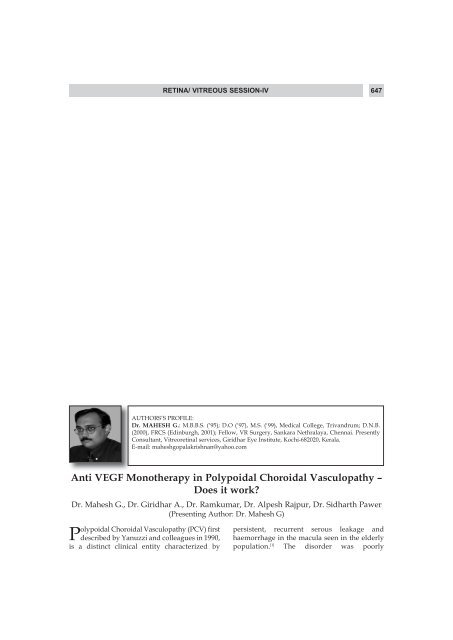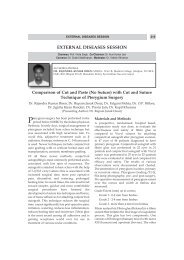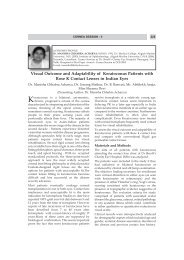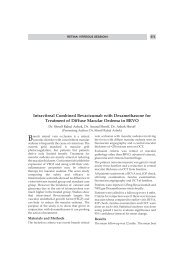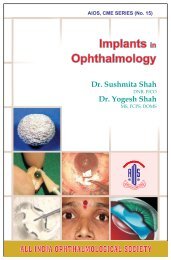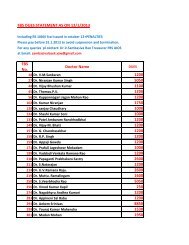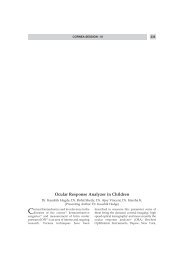Anti VEGF Monotherapy in Polypoidal Choroidal Vasculopathy ...
Anti VEGF Monotherapy in Polypoidal Choroidal Vasculopathy ...
Anti VEGF Monotherapy in Polypoidal Choroidal Vasculopathy ...
You also want an ePaper? Increase the reach of your titles
YUMPU automatically turns print PDFs into web optimized ePapers that Google loves.
RETINA/ VITREOUS SESSION-IV<br />
647<br />
AUTHORS’S PROFILE:<br />
Dr. MAHESH G.: M.B.B.S. (‘95); D.O (‘97), M.S. (‘99), Medical College, Trivandrum; D.N.B.<br />
(2000), FRCS (Ed<strong>in</strong>burgh, 2001); Fellow, VR Surgery, Sankara Nethralaya, Chennai. Presently<br />
Consultant, Vitreoret<strong>in</strong>al services, Giridhar Eye Institute, Kochi-682020, Kerala.<br />
E-mail: maheshgopalakrishnan@yahoo.com<br />
<strong>Anti</strong> <strong>VEGF</strong> <strong>Monotherapy</strong> <strong>in</strong> <strong>Polypoidal</strong> <strong>Choroidal</strong> <strong>Vasculopathy</strong> –<br />
Does it work?<br />
Dr. Mahesh G., Dr. Giridhar A., Dr. Ramkumar, Dr. Alpesh Rajpur, Dr. Sidharth Pawer<br />
(Present<strong>in</strong>g Author: Dr. Mahesh G)<br />
<strong>Polypoidal</strong> <strong>Choroidal</strong> <strong>Vasculopathy</strong> (PCV) first<br />
described by Yanuzzi and colleagues <strong>in</strong> 1990,<br />
is a dist<strong>in</strong>ct cl<strong>in</strong>ical entity characterized by<br />
persistent, recurrent serous leakage and<br />
haemorrhage <strong>in</strong> the macula seen <strong>in</strong> the elderly<br />
population. [1] The disorder was poorly
648 AIOC 2010 PROCEEDINGS<br />
understood earlier and <strong>in</strong>itially designated as<br />
‘recurrent ret<strong>in</strong>al pigment epithelial detachments<br />
and posterior uveal bleed<strong>in</strong>g syndrome. [2, 3, 4, 5] The<br />
primary abnormality as described by Yanuzzi [1,<br />
2,13]<br />
and colleagues <strong>in</strong>volves the choroidal<br />
circulation, and the characteristic lesion is an<br />
<strong>in</strong>ner choroidal vascular network of vessels<br />
end<strong>in</strong>g <strong>in</strong> an aneurismal bulge or outward<br />
projection, visible cl<strong>in</strong>ically as a reddish orange<br />
[7]<br />
spheroidal, polyp like structure. The exact<br />
pathogenesis of these vascular abnormalities is<br />
still not known. ICGA is essential for the<br />
diagnosis as it permits visualization of the<br />
choroidal vasculature with enhanced specificity<br />
and sensitivity. [13]<br />
Several reports have suggested that the <strong>in</strong>cidence<br />
of PCV is markedly high <strong>in</strong> black people,<br />
relatively high <strong>in</strong> Asian population and low <strong>in</strong><br />
white people <strong>in</strong> contrast to age related macular<br />
degeneration. [3-8] In blacks PCV affects women<br />
more frequently, is usually associated with<br />
peripapillary <strong>in</strong>volvement. [.2,3,4,8,9] Several reports<br />
from Asian population have shown a male<br />
preponderance, unilateral presentation with<br />
macular <strong>in</strong>volvement. [5,6,8,9] Many different<br />
treatment modalities have been used to preserve<br />
vision <strong>in</strong> patients with symptomatic PCV. Direct<br />
[2,5]<br />
laser photocoagulation feeder vessel<br />
treatment, [2, 7] [2, 9]<br />
Transpupillary thermo therapy,<br />
photodynamic therapy [18-23] are some of the<br />
modalities which have been described.<br />
Intravitreal anti <strong>VEGF</strong> monotherapy is the<br />
current gold standard for treatment of wet AMD.<br />
Its use <strong>in</strong> PCV <strong>in</strong> Indian patients is doubtful. This<br />
study is done to analyze the effect of anti <strong>VEGF</strong><br />
monotherapy and the use of thermal laser or<br />
photodynamic therapy <strong>in</strong> PCV.Here we present a<br />
series of 14 patients who was treated for<br />
serosangu<strong>in</strong>ous maculopathy by <strong>Anti</strong> <strong>VEGF</strong><br />
monotherapy and worsened.<br />
To evaluate the effect of <strong>in</strong>travitreal anti <strong>VEGF</strong><br />
drugs <strong>in</strong> <strong>Polypoidal</strong> <strong>Choroidal</strong> <strong>Vasculopathy</strong><br />
(PCV).<br />
Materials and Methods<br />
It was a retrospective non comparative case<br />
series.14 patients were enrolled <strong>in</strong> this study.<br />
Duration of the study was between January 2007<br />
and December 2008. There were 8 males and 6<br />
females. Age of the patients ranges from 52 years<br />
to 78 years with a mean age of 64.5 years. All the<br />
patients underwent complete ocular exam<strong>in</strong>ation<br />
<strong>in</strong>clud<strong>in</strong>g best Corrected Visual Acuity, ETDRS<br />
Visual Acuity, Refraction, and Intra Ocular<br />
Pressure measurement, Colour Fundus<br />
Photography, Fluoresce<strong>in</strong> Angiography,<br />
Indocyan<strong>in</strong>e Green Angiography and Optical<br />
Coherence Tomography. A diagnosis of<br />
<strong>Polypoidal</strong> <strong>Choroidal</strong> <strong>Vasculopathy</strong> was made<br />
based on ICG f<strong>in</strong>d<strong>in</strong>gs of dilated bulbous<br />
choroidal vessels with or without <strong>in</strong>terconnected<br />
network of large choroidal vessels <strong>in</strong> ICGA.<br />
Increase <strong>in</strong> the fluorescence with fussy marg<strong>in</strong>s<br />
<strong>in</strong> the late phase of the ICG angiogram was taken<br />
as active polyp. The exclusion criteria were:<br />
1. Large sub macular haemorrhage which<br />
required pneumatic displacement.<br />
2. Any relative contra <strong>in</strong>dication to systemic<br />
anti<strong>VEGF</strong> drug<br />
All the patients received anti<strong>VEGF</strong> monotherapy<br />
<strong>in</strong>itially. 12 patients received Bevacizumab<br />
1.25mg, one patient received Pegaptanib Sodium<br />
0.3mg and one patient received 0.5mg<br />
Ranibizumab. They were followed-up monthly<br />
for the first three months and then every 3<br />
months. In each follow-up visit OCT was done<br />
besides visual acuity and <strong>in</strong>tra ocular pressure.<br />
Outcome measures were<br />
1. Best Corrected Visual Acuity<br />
2. Mean Central Macular Thickness <strong>in</strong> OCT<br />
3. Any complications.<br />
Worsen<strong>in</strong>g of the condition was def<strong>in</strong>ed as drop<br />
of more than one l<strong>in</strong>e Snellen’s Visual acuity or<br />
<strong>in</strong>crease <strong>in</strong> more than 100 microns of ret<strong>in</strong>al<br />
thickness. In case of worsen<strong>in</strong>g repeat ICG<br />
angiogram was done and patient was selected for<br />
laser photocoagulation. If the leak<strong>in</strong>g polyps<br />
were subfoveal, photodynamic therapy us<strong>in</strong>g<br />
Visudyne was done. If the polyps leaked from<br />
outside the foveal avascular zone, thermal laser<br />
was used. Here whiten<strong>in</strong>g of the lesion us<strong>in</strong>g<br />
laser was used as an end po<strong>in</strong>t. Follow<strong>in</strong>g laser,<br />
patients were reviewed every three months.<br />
Results<br />
All the patients enrolled <strong>in</strong> the study had either<br />
exudative maculopathy or serosangu<strong>in</strong>ous<br />
maculopathy. The average mean follow up<br />
duration was 8 months. All 14 patients had<br />
worsen<strong>in</strong>g of the cl<strong>in</strong>ical conditions after<br />
anti<strong>VEGF</strong> monotherapy. They were switched
RETINA/ VITREOUS SESSION-IV<br />
649<br />
over to laser treatment <strong>in</strong> that situation. A total<br />
of 31 <strong>in</strong>jections were given as part of anti<strong>VEGF</strong><br />
monotherapy <strong>in</strong> 14 eyes with a mean <strong>in</strong>jection<br />
rate of 2.2. S<strong>in</strong>ce there was worsen<strong>in</strong>g either<br />
photodynamic therapy or thermal laser was done<br />
depend<strong>in</strong>g on the location of the polyp.<br />
Complications of monotherapy <strong>in</strong>cluded massive<br />
vitreous haemorrhage <strong>in</strong> one patient with subret<strong>in</strong>al<br />
haemorrhage. This patient underwent<br />
vitreous surgery later with a f<strong>in</strong>al visual acuity of<br />
3/60. All the 13 other eyes photodynamic<br />
therapy was done <strong>in</strong> 6 eyes and thermal laser was<br />
done <strong>in</strong> 7 eyes. Photodynamic therapy was<br />
performed us<strong>in</strong>g reduced fluency with Visudyne.<br />
Thermal laser was done us<strong>in</strong>g a double<br />
frequency YAG laser with a spot size of 50-100<br />
microns.<br />
At the last follow up there was stabilization of<br />
1. Yannuzzi L, Sorenson J, Spaide RF. Lipson B.<br />
Idiopathic <strong>Polypoidal</strong> <strong>Choroidal</strong> <strong>Vasculopathy</strong>.<br />
Ret<strong>in</strong>a. 1990;10:1-8<br />
2. Yannuzzi L, Ciardella A, Spaide RF, Rabb M,<br />
Freund KB, Orlock DA. The expand<strong>in</strong>g cl<strong>in</strong>ical<br />
spectrum of idiopathic polypoidal <strong>Choroidal</strong><br />
vasculopathy. Arch Ophthalmol 1997;115:478–85.<br />
3. Stern RM, Zakov ZN, Zegarra H, Gutman FA.<br />
Multiple recurrent serosangu<strong>in</strong>eous ret<strong>in</strong>al pigment<br />
epithelial detachments <strong>in</strong> black women. Am J<br />
Ophthalmol. 1985;100:560-9.<br />
4. Kle<strong>in</strong>er RC, Brucker AJ, Johnston RL. Posterior<br />
uveal bleed<strong>in</strong>g syndrome. Ophthalmology<br />
1984;91:110.<br />
5. Sho K, Takahashi K, Yamada H, Wada M, Nagai Y,<br />
Otsuji T, et al. <strong>Polypoidal</strong> <strong>Choroidal</strong> vasculopathy:<br />
<strong>in</strong>cidence, demographic features, and cl<strong>in</strong>ical<br />
characteristics. Arch Ophthalmol. 2003;121:1392–6.<br />
6. Uyama M, Wada M, Nagai Y, Matsubara T,<br />
Matsunaga H, Fukushima I, et al. <strong>Polypoidal</strong><br />
<strong>Choroidal</strong> <strong>Vasculopathy</strong>. Natural history. Am J<br />
Ophthalmol. 2002;133:639–48.<br />
7. Moorthy RS, Lyon AT, Rabb MF. Idiopathic<br />
<strong>Polypoidal</strong> <strong>Choroidal</strong> <strong>Vasculopathy</strong> of the macula.<br />
Ophthalmology. 1998;105:1380–5.<br />
8. Ciardella AP, Donsoff IM, Huang SJ, Costa DL,<br />
Yanuzzi LA. <strong>Polypoidal</strong> choroidal vasculopathy.<br />
Surv Ophthalmol. 2004;49:25-37.<br />
9. Fumi Gomi, Yasuo Tano. <strong>Polypoidal</strong> <strong>Choroidal</strong><br />
<strong>Vasculopathy</strong> and treatments. Curr Op<strong>in</strong><br />
Ophthalmol. 2008;19:208-12.<br />
10. Kwok AKH, Lai TYY, Chan CWN, Neoh EL, Lam<br />
DSC. <strong>Polypoidal</strong> choroidal vasculopathy <strong>in</strong> Ch<strong>in</strong>ese<br />
patients. Br J Ophthalmol. 2002;86:892–7.<br />
References<br />
vision <strong>in</strong> one eye and improvement of vision <strong>in</strong><br />
12 eyes. One eye with vitreous haemorrhage had<br />
dropped <strong>in</strong> f<strong>in</strong>al visual acuity.<br />
Discussion<br />
This study evaluates the effect of <strong>in</strong>travitreal anti<br />
<strong>VEGF</strong> <strong>in</strong>jections and the effect of thermal laser<br />
/photodynamic therapy <strong>in</strong> PCV <strong>in</strong> Indian<br />
population. 14 eyes with PCV showed worsen<strong>in</strong>g<br />
after a mean 2.2 <strong>in</strong>jections of anti <strong>VEGF</strong> drugs.<br />
Subsequently they received thermal laser (7) or<br />
PDT (6) with improvement of vision <strong>in</strong> 12 eyes.<br />
There are not many literature on the role of <strong>VEGF</strong><br />
<strong>in</strong> the pathogenesis of PCV. Laser ablation works<br />
well <strong>in</strong> this situation. The study demonstrates the<br />
<strong>in</strong>efficacy of anti <strong>VEGF</strong> monotherapy <strong>in</strong> PCV.<br />
<strong>Anti</strong> <strong>VEGF</strong> monotherapy without thermal laser<br />
or photodynamic therapy is futile <strong>in</strong> PCV.<br />
11. Uyama M, Matsubara T, Fukushima I, Matsuaga H,<br />
Iwashita K, Nagai Y, et al. Idiopathic polypoidal<br />
<strong>Choroidal</strong> vasculopathy <strong>in</strong> Japanese patients. Arch<br />
Ophthalmol 1999;117:1035–42.<br />
12. Wen F, Liu Y, Huans S. <strong>Polypoidal</strong> <strong>Choroidal</strong><br />
<strong>Vasculopathy</strong> <strong>in</strong> elderly Ch<strong>in</strong>ese patients. Graefes<br />
Arch Cl<strong>in</strong> Exp Ophthalmol. 2004:242:625-9.<br />
13. Spaide RF, Yanuzzi LA, Slakter JS. Sorenson J,<br />
Orlach DA. Indocynan<strong>in</strong>e Green Videoangiography<br />
of idiopathic <strong>Polypoidal</strong> choroidal <strong>Vasculopathy</strong>.<br />
Ret<strong>in</strong>a. 1995:15:100-10.<br />
14. Byeon SH, Lee SC, Oh HS, Kim SS, Koh HJ.<br />
Incidence and Cl<strong>in</strong>ical Patterns of <strong>Polypoidal</strong><br />
<strong>Choroidal</strong> <strong>Vasculopathy</strong> <strong>in</strong> Korean patients. Jpn J<br />
Ophthalmol 2008;52:57-62.<br />
15. Treatment of Age Related Macular Degeneration<br />
with Photodynamic Therapy (TAP) Study Group.<br />
Photodynamic therapy of Sub-foveal <strong>Choroidal</strong><br />
Neovascularization <strong>in</strong> age-related macular<br />
degeneration with verteporf<strong>in</strong>. One year results of 2<br />
randomized cl<strong>in</strong>ical trial – TAP report 1. Arch<br />
Ophthalmol 1999;117:1329-45.<br />
16. Chan WM, Lam DS, Lai TY, Lui DT, Li KK, Yao Y.<br />
Photodynamic therapy with verteporf<strong>in</strong> for<br />
symptomatic <strong>Polypoidal</strong> Chroidal <strong>Vasculopathy</strong>.<br />
One year result of a prospective case series.<br />
Ophthalmology. 2004;111:1576-84.<br />
17. Spaide RF, Donsoff L, Lam DL. Treatment of<br />
<strong>Polypoidal</strong> <strong>Choroidal</strong> <strong>Vasculopathy</strong> with<br />
photodynamic therapy. Ret<strong>in</strong>a. 2002;22:529-35.<br />
18. Hussa<strong>in</strong> N, Hussa<strong>in</strong> A, Natarajan S. Role of<br />
Photodynamic Therapy <strong>in</strong> <strong>Polypoidal</strong> <strong>Choroidal</strong><br />
<strong>Vasculopathy</strong>. Indian J Ophthalmol 2005;53:101-4.<br />
19. Fumi Gomi, Masahito Oji, Kaon Sayanagi,
650 AIOC 2010 PROCEEDINGS<br />
Mikisawa, Hiroku, Sakaguchi et al. One year<br />
outcome of photodynamic therapy <strong>in</strong> age related<br />
macular degeneration and <strong>Polypoidal</strong> <strong>Choroidal</strong><br />
<strong>Vasculopathy</strong> <strong>in</strong> Japanese patients. Ophthalmology.<br />
2008;115:141-6.<br />
20. Silva RM, Figueria. J, Cachulo. M L. <strong>Polypoidal</strong><br />
<strong>Choroidal</strong> <strong>Vasculopathy</strong> and photodynamic<br />
therapy with verteporf<strong>in</strong>. Graefes Arch Cl<strong>in</strong> Exp<br />
Ophthalmol. 2005;243:973-9.<br />
21. Eriko Azara, Ryusabur D, Mori, Mitsuko Yazawa.<br />
Long term results of Photodynamic therapy of<br />
<strong>Polypoidal</strong> <strong>Choroidal</strong> <strong>Vasculopathy</strong>. Ret<strong>in</strong>a.<br />
2008;28:717-21.<br />
22. Hirami J, Tsujikawa A, Otani A, Yodoi Y.<br />
Hemorrhagic complications after photodynamic<br />
therapy for <strong>Polypoidal</strong> <strong>Choroidal</strong> <strong>Vasculopathy</strong>.<br />
Ret<strong>in</strong>a. 2007;27:335-41.<br />
23. Rishi P, Kadekar A, Rishi E’ Breakthrough vitreous<br />
haemorrhage after ICGA guided PDT for<br />
<strong>Polypoidal</strong> <strong>Choroidal</strong> <strong>Vasculopathy</strong>. Indian J<br />
Ophthalmol. 2009;57:160-1.<br />
24. Peter Cackett, Doric Wong, Ian Yeo. A classification<br />
system for <strong>Polypoidal</strong> <strong>Choroidal</strong> <strong>Vasculopathy</strong>.<br />
Ret<strong>in</strong>a. 2009;29:187-91.<br />
25. Lee MW, Yeo I, Wong D, Ang CL. Argon Laser<br />
photocoagulation for the treatment of <strong>Polypoidal</strong><br />
<strong>Choroidal</strong> <strong>Vasculopathy</strong>. Eye. 2009;23:145-8.<br />
26. Ladas ID, Karagiannis DA, Georgalas I, Rouvas AA,<br />
Muschas MM. <strong>Polypoidal</strong> <strong>Choroidal</strong> <strong>Vasculopathy</strong><br />
associated with Doyne’s familial choroidities:<br />
treatment with thermal laser. Eur J Ophthalmol. 2004;<br />
14:264-8.<br />
27. Nishijima K, Takahashi M, Akita J, Katsuta H,<br />
Tanemura M, Aikawa H. Laser Photocoagulation of<br />
<strong>in</strong>docyan<strong>in</strong>e green angiographically identified<br />
feeder vessels to idiopathic <strong>Polypoidal</strong> <strong>Choroidal</strong><br />
<strong>Vasculopathy</strong>. Am J Ophthalmol. 2004;138:693-4.<br />
28. Mitamura Y, Kubota-Taniai M, Okada K, Kitahashi<br />
M, Baba T, Mizunoya S. et al. Comparison of<br />
photodynamic therapy to transpupillary<br />
thermotherapy for polypoidal choroidal<br />
vasculopathy. Eye. 2009;23:67-72.


